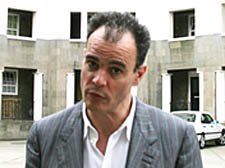|
|
 |
| |

Jake Arnott visits Levita House, Ossulston Street, in Somers Town |
Arnott's Angry Brigade
Jake Arnott’s latest thriller is set at the incendiary moment when fashion came up against politics in the early 1970s. He talks to Mairi MacDonald
Writer Jake Arnott has set his fourth novel, Johnny Come Home, within spitting distance of a squat in Somers Town.
The year is 1972 and the anarchist group the Angry Brigade has the law hot on its heels following a series of bombings across the capital.
A new wave of gender-bending youth culture has teenage boys stomping round in platform heels and women’s clothing and has turned fantasy characters like David Bowie’s Ziggy Stardust into heroes.
At 43, Arnott was barely out of short trousers in the early 1970s, but it was a character-defining era for him. Bowie and glam-rocker Marc Bolan of T-Rex, have shaped his musical taste – he recently dissected their influence in the Observer newspaper.
While he is most accurately described as a crime writer, Arnott’s attention to historical and cultural context is more significant than worrying about whodunit.
His first novel, The Long Firm, written in 1999, about gangland violence in the 1960s was credited with kick-starting ‘gangster-chic’ picked up by Guy Richie in his film Lock Stock and Two Smoking Barrels.
Two more successful novels followed, He Kills Coppers (2001) and Truecrime (2003).
Arnott was somewhat aware as a child of the bombing of the trendy Biba department store in Kensington in 1971, which is a focal point in Johnny Come Home and is used to show the rub between the radical conscience and the fashion conscious.
He explains: “The Angry Brigade took a Situationist approach getting at the state by using glitzy glam. The bombing of Biba and Miss World contests was because they were the hypothesis of the Situationist nightmare.”
He says: “There a really interesting juxtaposition of political movement and the strange over-the-top fashions and music going on that were all tied up with the glam rock phase. Some of the Angry Brigade’s notion was that the spectacle of society was in need of attack as well as the fabric.”
Arnott, 43, lives in Clerkenwell but spent much of the 1980s living in squats across London. Brought up in Buckinghamshire, coming to London as a youngster was a big deal.
Arnott says: “I had family in London. I remember Soho back then very well and being struck by how weird and wonderful it was.” He describes 1970s Camden as a place of heavy drinking and bar brawls, but grimmer and less trendy than what came later.
Arnott describes his man character, Sweet Thing, as Brechtian, and if for nothing else we should be grateful to Arnott for inventing him. An abused rent boy with a passion for shoplifting from Biba and high-maintenance lifestyles, he is the most interesting by far.
Arnott says: “Sweet Thing falls in with this lefty-leaning group of people that he doesn’t really get. He can’t understand why on earth anyone would want to blow up Biba.
“He is a pure capitalist and a survivor by necessity, He would have got Thatcherism completely.”
Pearson comes across less concretely, which Arnott puts down to their opposing images.
“Pearson was the first character I thought of. I had this image in my head of him walking through the West End, depressed and lost. He is very internalised whereas Sweet Thing is so explosive visually. The radical hippy look was not very dandy-ish, and deliberately drab. While at the other end of the spectrum it was very over the top, which I was drawn to.”
Through Sweet Thing, Arnott describes how male prostitution thrived in the West End, around the ‘Dilly’, and actual places such as the all-night chemist and the ironically named Playland “You couldn’t make it up,” says Arnott.
Locations are very important in the novel, setting the tone for each chapter. From Somers Town, the characters can conveniently walk to other key locations: Stoke Newington, where the radicals hang out, Soho, Hampstead for skinny dipping on the Heath and Camden Town for nights of heavy drinking.
It will serve it well when the book is dramatised for Channel Four in the coming months.
An attack on fashion
THE Angry Brigade was a libertarian, militant organisation that carried out a string of bombings between 1970 and 1972 on high-profile targets which they saw as representing the ills of capitalist society, such as the fashion store Biba and the Miss World Competition.
Targets also included embassies, transport hubs and the homes of the Metropolitan Police Commissioner Sir John Waldron, the Attorney General, Sir Peter Rawlinson, and employment minister Robert Carr. Nobody was badly hurt. In 1972 the police’s newly-formed Bomb Squad raided dozens of homes and charged 12 people.
After a famously long trial at the Old Bailey, Jim Greenfield, Anna Mendleson, Hilary Creek and John Barker were given 10-year sentences for conspiring to cause explosions.
Another suspect, Jake Prescott, was also sentenced to 10 years.
|
 |
| |
| |
| |
| |
 |
|
|
 |
|


